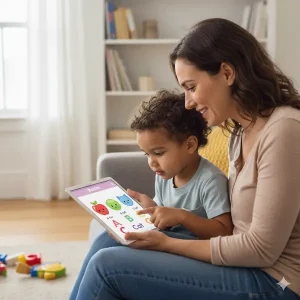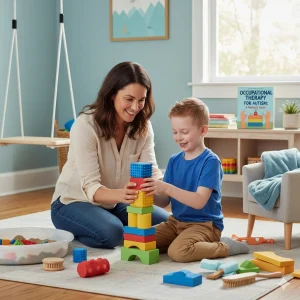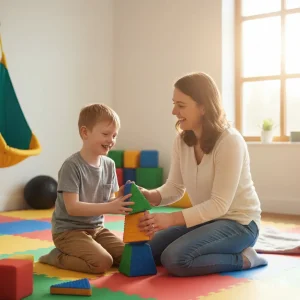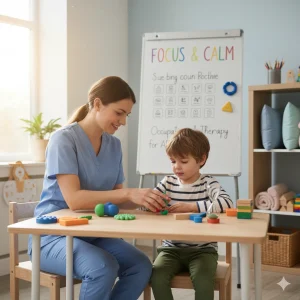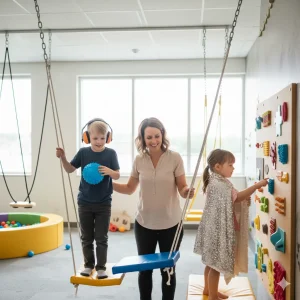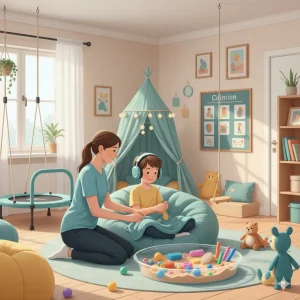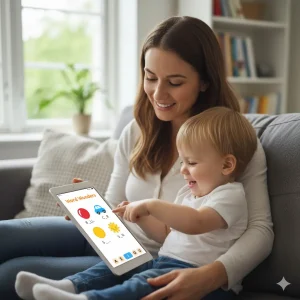My 3-Year-Old Doesn’t Tell Stories — Is This a Red Flag?
Last Updated: August 8, 2025
“Mommy, guess what happened today!”
For many parents, this playful sentence marks a magical milestone—your toddler stringing together thoughts, emotions, and imagination into a story. But what if your 3-year-old isn’t telling stories yet? Is it just a phase, or could it be a red flag for something more?
As a parent, it’s natural to worry when your child doesn’t hit common speech and language milestones. While every child develops at their own pace, the ability to tell simple stories—like what happened at preschool or during playtime—is a key part of early narrative development. It reflects their growing expressive language, imagination, and social communication.
Free Speech Help for Kids
Concerned about speech delays? Book a free consultation with our expert speech therapist and get guidance tailored to your child’s needs.
When Do Toddlers Start Telling Stories?
Many parents find themselves wondering: “When do toddlers tell stories?” While it may seem like a simple milestone, storytelling is actually a complex language skill that unfolds gradually—starting as early as age 2 and becoming more structured by age 4.
Timeline of Storytelling Milestones (Ages 2–4)
Storytelling development in toddlers doesn’t happen all at once—it builds on many smaller language milestones:
By Age 2:
- Most toddlers begin combining two to three words to express basic needs or describe simple events (e.g., “dog eat,” “mama go”).
- They may start imitating actions or snippets of conversations from adults, which is an early foundation for pretend play and storytelling.
By Age 3:
- Children usually start using short sentences to explain what happened during the day (“We go park,” “I eat apple”).
- They can sometimes sequence two events in order (“I fall. Then I cry.”), even if grammar and clarity are still developing.
- At this stage, a toddler may try to “tell stories” by recalling something that happened or imagining simple scenarios during play.
By Age 4:
- Most children can tell short, structured stories with a beginning, middle, and end.
- They start using more chronological language like “first,” “then,” and “after,” showing an emerging understanding of sequencing.
- Their imagination blossoms—they invent characters, retell favorite books, and engage in rich pretend play that mirrors real-life events.
It’s important to remember that these milestones are guidelines, not strict deadlines. Some children are natural storytellers early on, while others may need a bit more support as their expressive language develops.
Also read: Speech Development Milestones: Your Child’s Talking Journey
What Are Narrative Skills in Early Childhood?
Narrative skills refer to a child’s ability to tell a story, describe a sequence of events, or explain what happened—whether real or imaginary. These skills are more than just talking; they involve organizing thoughts, using appropriate vocabulary, and following a logical flow.
Narrative development is a cornerstone of early speech and language growth. Strong narrative skills help children:
- Communicate clearly
- Connect socially with peers
- Build vocabulary
- Prepare for reading and writing in school
Here’s how narrative skills evolve in early childhood:
1. Sequencing
Children learn to place events in logical order: “We went outside. Then I saw a cat. Then we came home.” This is one of the earliest signs of storytelling ability.
2. Pretend Play and Storytelling
When toddlers act out stories with dolls or toys (“baby sleeps,” “puppy eats”), they’re practicing storytelling in action. Pretend play fuels the imagination and gives toddlers a safe space to explore and narrate ideas.
Read more: Pretend Play Ideas for Late Talkers: Build Speech Skills Naturally
3. Chronological Language
Words like “first,” “then,” and “later” begin to appear as children learn to express time and sequence—essential components of a clear narrative.
These early narrative skills are crucial not just for storytelling, but for day-to-day communication. Whether explaining a scraped knee or recalling a visit to grandma’s house, the ability to tell stories helps children connect their world to words.
Is It Normal for a 3-Year-Old Not to Tell Stories?
If your 3-year-old isn’t telling stories yet, you’re not alone—and it doesn’t automatically mean something is wrong. One of the most common questions parents ask is, “Is it normal for a 3-year-old not to tell stories?” The short answer is: Yes, it can be. Every child develops at their own pace, and storytelling is a complex skill that takes time to emerge.
Understanding What’s “Normal” at Age 3
By age 3, many children are beginning to use 3-4 word sentences, label emotions, describe basic events, and engage in pretend play. Some may start stringing together simple story-like thoughts, such as “We go zoo. I see lion. Lion roar.” But not all toddlers hit these milestones at the same time.
Here are a few age 3 speech expectations to consider:
- Using 200–500 words, though vocabulary size varies widely
- Naming familiar people, objects, or actions
- Answering basic questions like “What’s that?” or “Where’s mommy?”
- Imitating daily routines during play (e.g., pretending to cook or go shopping)
- Expressing ideas, but not always in clear or complete sentences
If your toddler is not telling stories, but is still communicating in other ways (like naming things, pointing, or using gestures), that’s often a sign that their language skills are still developing, not that they’re delayed.
Every Child Develops Differently
It’s easy to compare your child to others at the park or in playgroup, but remember:
- Some children are early talkers, while others focus first on physical skills like climbing or running
- Bilingual children may take longer to form sentences in each language, which can affect how soon they begin storytelling
- Shy or introverted toddlers may have rich inner stories, but may not share them out loud yet
Instead of worrying about what your child isn’t doing, look at how they’re communicating overall. Do they:
- Show interest in books or pretend play?
- Respond when spoken to?
- Try to express their needs—even in simple ways?
If so, your child is likely on track, even if they aren’t telling full stories yet.
When to Keep Watching
While it’s normal for some 3-year-olds not to tell stories, it’s still helpful to keep an eye on broader speech and language milestones. If your child:
- Struggles to combine words into sentences
- Rarely engages in pretend play
- Doesn’t respond to simple questions or directions
- Seems uninterested in talking or connecting with others
…it may be worth discussing with your pediatrician or a speech-language pathologist.
Red Flags — When Should You Be Concerned?
While it’s completely normal for toddlers to hit milestones at different times, there are certain red flags in toddler development that may signal it’s time to seek extra support. If your 3-year-old isn’t telling stories, and you’ve noticed other signs that make you pause, it’s worth paying closer attention.
Not telling stories by age 3 isn’t always a cause for alarm—but when combined with other developmental concerns, it may point to a possible speech delay, expressive language issue, or even an early sign of autism spectrum disorder.
Speech Delay Signs in Toddlers
Some children are late talkers and catch up on their own, but others may need help building their language skills. Here are some common speech delay signs in toddlers:
- Limited vocabulary for their age (fewer than 50 words by age 2.5–3)
- Difficulty combining words into simple sentences
- Frequent frustration when trying to communicate
- Not asking or answering questions by age 3
- Speech that’s hard for even parents to understand
If your toddler can name things but struggles with imaginative language, story sequencing, or describing events, it could be a sign of an expressive language delay—especially if they’re not making progress over several months.
Autism Signs in a 3-Year-Old
Storytelling is more than just talking—it reflects social understanding, imagination, and the ability to connect experiences with others. If your child isn’t telling stories and also shows limited interest in people, activities, or pretend play, you might be seeing early autism signs in a 3-year-old.
Common red flags include:
- Limited or absent eye contact
- Difficulty understanding or using gestures (like pointing or waving)
- Lack of interest in peers or social games
- Repetitive behaviors (lining up toys, flapping hands)
- Unusual tone of voice or sing-song speech
- Avoiding pretend play (e.g., not pretending to feed a doll or drive a car)
These are considered social communication red flags and may suggest your child needs further evaluation.
Related Signs to Watch Alongside Lack of Storytelling
If your toddler isn’t telling stories and is also missing other developmental milestones, it could be time to speak with your pediatrician. Some important signs to look out for include:
1. Poor Eye Contact
- Your child avoids looking at your face or eyes during play or communication
- They don’t respond to their name or show shared attention (e.g., looking at something you point to)
2. No Pretend Play
- Pretend play and storytelling go hand in hand.
- If your child doesn’t mimic real-life actions with toys (e.g., pretending to eat, sleep, drive), they may be missing imaginative language milestones
3. Lack of Interest in Social Interaction
- Not seeking out others to play
- Prefers to play alone most of the time
- Doesn’t imitate others or engage in back-and-forth games
Each of these signs on their own might not mean there’s a serious issue. But when they appear together with a lack of storytelling, they could suggest a deeper need for support—whether it’s early intervention for language delay, social development, or a developmental screening for autism.
Reasons Your Child Might Not Be Telling Stories Yet
If your 3-year-old is not narrating events or struggles to describe what happened during their day, it’s natural to feel a bit concerned. But before jumping to conclusions, it’s important to understand that storytelling in toddlers involves many interconnected skills—speech, memory, imagination, and social awareness—all of which develop at different rates for every child.
There are several common reasons why your child might not be telling stories yet, and many of them are completely normal or manageable with the right support.
1. Language Delay
One of the most common reasons behind delayed storytelling is a language delay—specifically in expressive language, which is the ability to put thoughts into words.
Children with a language delay may:
- Use fewer words than expected for their age
- Struggle to form complete sentences
- Have trouble recalling and sequencing events
- Speak only when prompted, not spontaneously
If your child understands you well but finds it hard to express ideas or tell a simple story, this may point to a delay in their toddler speech development—not necessarily a serious condition, but one that may benefit from early speech therapy.
2. Growing Up in a Bilingual Household
If your child is learning two or more languages at once, you may notice that they take longer to start speaking fluently or telling stories in either language. This is completely normal.
In bilingual households, toddlers often:
- Mix languages when speaking
- Take more time to organize their thoughts
- Focus more on understanding both languages before fully expressing themselves
While this may look like your 3-year-old is not narrating events, it’s often just a temporary stage as their brain works to absorb both languages. Most bilingual children catch up by age 4 or 5 and go on to have strong language skills in both languages.
3. Shyness or Reserved Temperament
Not all children are natural talkers—and that’s okay. Some toddlers are simply more reserved, and may:
- Be reluctant to speak around others
- Prefer listening over talking
- Show a rich imagination through play, but not always verbalize it
If your child seems shy but engages well through pretend play, follows directions, and understands what others say, their storytelling might just take a little more time to emerge. Often, creating a safe, low-pressure environment can encourage even the quietest child to open up.
4. Autism or Developmental Differences
In some cases, difficulty with storytelling may be an early sign of a developmental condition such as autism spectrum disorder (ASD).
Children on the spectrum may:
- Avoid or struggle with pretend play
- Use very literal language and have trouble with imagination
- Find it difficult to understand sequencing, time, or emotions
- Have limited interest in sharing experiences verbally
If your child isn’t just avoiding stories but also shows limited eye contact, repetitive behaviors, or challenges in social communication, it may be worth discussing an evaluation with a pediatrician or specialist.
Every Child Has Their Own Pace
Whether your child is quiet, learning two languages, or just not developmentally ready, the key is to look at the big picture of their toddler speech development. Are they making progress over time? Are they showing curiosity, trying new words, or engaging in any form of communication?
If so, their storytelling skills may just be developing quietly in the background—ready to blossom with a little encouragement.
How to Encourage Storytelling in Your 3-Year-Old
If your child isn’t quite spinning stories yet, don’t worry—storytelling is a skill that can be nurtured over time. The good news is that you don’t need fancy tools or advanced techniques. The most effective ways to build storytelling skills are rooted in play, connection, and everyday conversations.
Wondering how to help your 3-year-old develop storytelling skills? It starts with creating a language-rich environment where your child feels safe, curious, and excited to share their world with you—one word (or pretend adventure) at a time.
1. Encourage Pretend Play Every Day
Pretend play is one of the most powerful tools for storytelling development. When your child uses toys to mimic real-life scenarios—like feeding a baby doll, driving a toy car, or going to the doctor—they’re building the foundations of storytelling: character, setting, and sequence.
Try these simple storytelling activities for toddlers:
- Give your child toy animals or dolls and ask, “What are they doing today?”
- Use a dollhouse or kitchen set to act out morning routines or family scenes.
- Pretend you’re animals on an adventure and take turns adding to the story.
This type of play helps toddlers practice sequencing events, using descriptive language, and understanding how one action leads to another.
2. Make Reading Interactive
Reading is a natural doorway into storytelling. Instead of simply reading a book to your child, try reading with them. Pause to ask questions, let them guess what might happen next, or invite them to help tell the story.
Here’s how to make books more interactive:
- Ask open-ended questions like “Why do you think the bear is sad?”
- Pause and let your child fill in the blanks: “The girl opened the door and…”
- After the story, ask your child to retell it in their own words—this builds memory and sequencing.
Even if they only remember a few details, this practice helps them build narrative confidence. Over time, their ability to structure a story with a beginning, middle, and end will grow.
3. Use Role-Playing and Real-Life Routines
Daily routines offer endless chances to practice storytelling in real life. Turn bath time, cooking, or grocery shopping into mini storytelling sessions.
Here are a few ideas:
- During bath time: “Can you tell me a story about your rubber duck’s day?”
- After school: “What happened first, next, and last at playgroup?”
- While cooking: “Let’s pretend we’re chefs making a surprise meal for a king!”
These moments naturally blend play-based language therapy into everyday activities. They also help children connect language to action and time—key ingredients in storytelling.
4. Create and Tell Stories Together
Help your child create simple stories using their drawings, toys, or even photo books of family trips. You can prompt them with questions like:
- “Who is the main character?”
- “What happened at the beginning?”
- “How did it end?”
You might start the story, then pause and let your child fill in the next part. This co-creation builds their confidence, vocabulary, and imagination—all while strengthening your bond.
Consistency Over Perfection
You don’t need to teach your child to become a master storyteller overnight. Instead, focus on consistent exposure to rich language experiences. The more your toddler hears, sees, and practices storytelling—through play, books, and conversation—the stronger their skills will become.
Remember: Every story your child tells, no matter how short or silly, is a step toward stronger communication and emotional expression.
When to Seek Help From a Speech Therapist
While every child develops at their own pace, there are times when extra support can make all the difference. If your 3-year-old still isn’t telling stories, struggles with sentence formation, or shows signs of frustration when trying to express themselves, it may be time to consider speaking with a professional—specifically, a Speech-Language Pathologist (SLP).
Knowing when to consult an SLP can help you catch potential delays early, provide your child with the support they need, and give you peace of mind.
Why Early Support Matters
Research consistently shows that early intervention for language delay leads to better outcomes. The earlier a child receives help, the easier it is to build the foundational language and communication skills needed for future learning, socializing, and emotional development.
If your child:
- Rarely uses sentences or avoids talking
- Doesn’t understand simple directions
- Can’t describe or recall events (like what happened at school or during play)
- Struggles with sequencing or imaginative play
- Shows no progress in storytelling despite your efforts
…these could be signs that your child needs professional speech therapy for toddlers.
An SLP can assess whether your child’s language development is on track and offer personalized strategies to help them build storytelling skills, understand sequencing, and express their thoughts more clearly.
Digital Tools That Can Help
If you’re not sure where to start—or if in-person sessions aren’t accessible—there are excellent online therapy tools that can guide you through early support.
One example is the BASICS App, a parent-friendly digital platform designed by speech therapists to help toddlers build essential communication skills. It includes:
- Daily storytelling prompts
- Play-based language activities
- Visual supports and child-friendly routines
- Progress tracking and feedback tools
Apps like BASICS make speech therapy more accessible and can supplement professional support or help parents take proactive steps while waiting for an appointment.
How SLPs Support Storytelling Skills
A qualified SLP doesn’t just help with sounds and words—they can:
- Teach your child how to sequence events in a story
- Encourage use of descriptive and chronological language
- Model age-appropriate storytelling through visuals and play
- Provide exercises that improve memory, focus, and vocabulary
- Coach parents on how to continue the learning at home
Whether your child has a mild delay or a more complex challenge, SLP help for storytelling delay can empower them to communicate with confidence and creativity.
Final Thought
Not every child who struggles with storytelling has a serious problem—but if your gut tells you something isn’t quite right, don’t hesitate to explore support. Sometimes, a short burst of targeted speech therapy is all it takes to unlock your child’s inner storyteller.
Conclusion
Not all delays mean something is wrong. Some toddlers take more time to talk or tell stories—and that’s okay. But if your 3-year-old isn’t telling stories, it’s worth keeping an eye on their speech and play. With early support, kids can catch up quickly. You can help your child with simple storytelling activities for toddlers or explore tools like the BASICS App for fun, guided speech practice. Worried about your child’s language development? Try our easy tools or talk to a speech expert today—because early help makes a big difference.
Frequently Asked Questions:
1. Is it normal for a 3-year-old not to tell stories?
Yes, it can be completely normal. Storytelling is a skill that develops gradually, and some toddlers take more time than others. By age 3, many children start to talk about simple things that happened in their day, but not all will be able to tell full stories yet. If your child is using words, forming basic sentences, and showing interest in pretend play or books, they may just be developing at their own pace. Not telling stories at 3 doesn’t always mean something is wrong.
2. When do toddlers usually start telling stories?
Most toddlers begin telling very simple stories between ages 2.5 and 4. It often starts with short phrases like “We go park” or “I eat cookie,” and slowly grows into longer sentences with some sequence. By age 4, many kids can tell a story with a beginning, middle, and end. This is part of normal storytelling development in toddlers, and every child’s timeline can look different.
3. Why is my toddler not telling stories yet?
There are several possible reasons. Your toddler may be naturally quiet, still learning to speak, or adjusting to speaking two languages. Some kids are more focused on physical skills like climbing or drawing before they focus on storytelling. In other cases, delays in language development, speech issues, or a developmental condition like autism could be factors. If your child struggles to explain things or doesn’t seem interested in using words, it’s a good idea to talk to a speech therapist.
4. What are signs of a speech delay in a 3-year-old?
Common speech delay signs in toddlers include:
- Speaking fewer than 50–100 words
- Not putting two or more words together (e.g., “want juice”)
- Difficulty answering questions or naming familiar objects
- Speech that’s hard for others to understand
- Little progress in talking over several months
If your child doesn’t try to narrate events or describe things that happen, it could also be a sign of an expressive language delay.
5. Can lack of storytelling be a sign of autism in toddlers?
It can be, especially when combined with other behaviors. Many children with autism have difficulty with imaginative language, pretend play, and social storytelling. If your toddler isn’t telling stories and also avoids eye contact, doesn’t respond to their name, prefers to play alone, or repeats actions (like lining up toys), it’s a good idea to consult your pediatrician. These may be early autism signs in a 3-year-old.
6. How can I help my 3-year-old tell stories?
You can build storytelling skills through fun, everyday activities. Try:
- Pretend play with dolls, toy animals, or kitchen sets
- Reading picture books and asking “What do you think will happen next?”
- Talking about your day and encouraging your child to describe what they saw or did
- Using toys to act out stories and taking turns to add parts to it
These are great storytelling activities for toddlers, and they also support memory, sequencing, and vocabulary growth.
7. Do bilingual kids start storytelling later?
Yes, that’s very common and completely normal. Children learning more than one language may take longer to speak or tell stories clearly in each language. Their brains are working hard to understand two language systems at once. This may look like a delay, but bilingual toddlers usually catch up by age 4 or 5 and go on to be great storytellers in both languages.
8. Should I worry if my 3-year-old talks but doesn’t tell stories?
Not necessarily. If your child can speak, follow instructions, and interact with others, they might simply not be interested in storytelling yet. Some toddlers prefer physical play, while others love books and talking. Focus on their overall speech development, not just one skill. If they’re making progress and using more words over time, they’re likely on track—even if they don’t “tell stories” the way you expect.
9. When should I take my child to a speech therapist?
You should consider consulting a Speech-Language Pathologist (SLP) if:
- Your child isn’t speaking in full phrases by age 3
- They don’t seem to understand basic instructions
- They’re not interested in pretend play or interaction
- They’re not improving or seem frustrated when trying to talk
Early support through speech therapy for toddlers can really help. The earlier you start, the easier it is to build strong language skills. SLPs also help with storytelling delays and teach fun ways to help your child express themselves better.
10. Are there any tools or apps to help my toddler talk more?
Yes! There are helpful resources like the BASICS App, which offers:
- Storytelling prompts for toddlers
- Simple language-building activities
- Visual support and play ideas created by speech therapists
- Progress tracking for parents
Apps like BASICS can make speech practice at home easy and fun, especially when combined with everyday play and reading routines.
About the Author:
Anuradha Karanam
Speech-language pathologist (7+ years of experience)
Anuradha Karanam is a skilled speech-language pathologist with over 6 years of experience. Fluent in Tamil, Telugu, Hindi, and English, she specializes in parent counseling, speech sound disorders, fluency assessment, and speech-language evaluations. Anuradha excels at working with children with developmental disorders, offering creative and effective therapy programs. Currently, at Wellness Hub, she holds a BASLP degree and is registered with the RCI (CRR No A85500). Her patience, ambition, and dedication make her a trusted expert in her field.
Book your Free Consultation Today
Parent/Caregiver Info:
Client’s Details:
* Error Message
